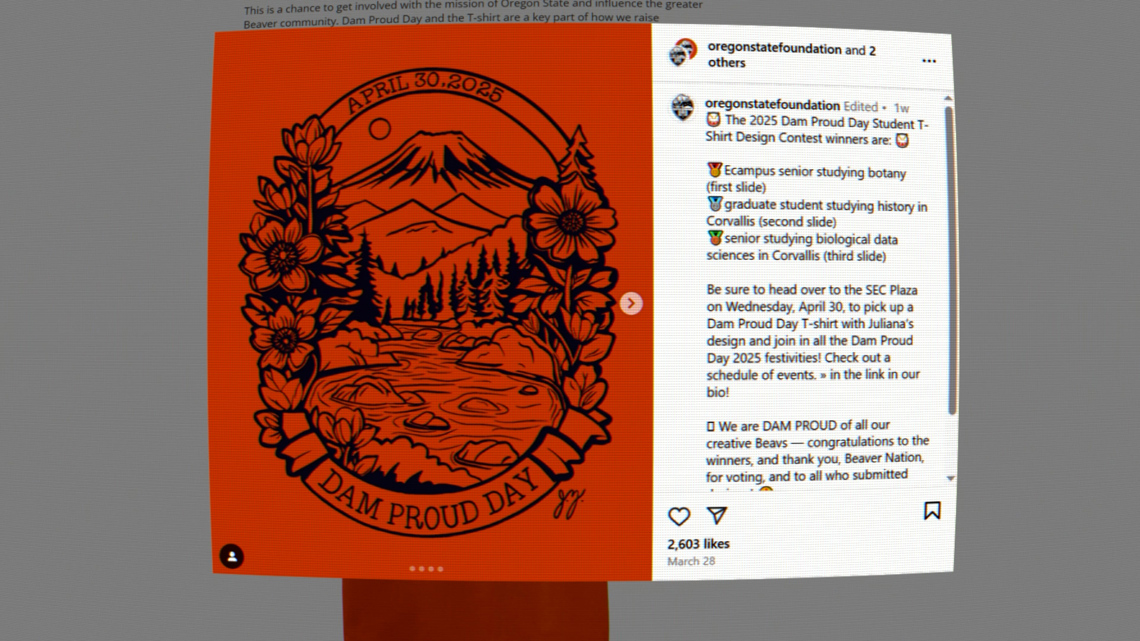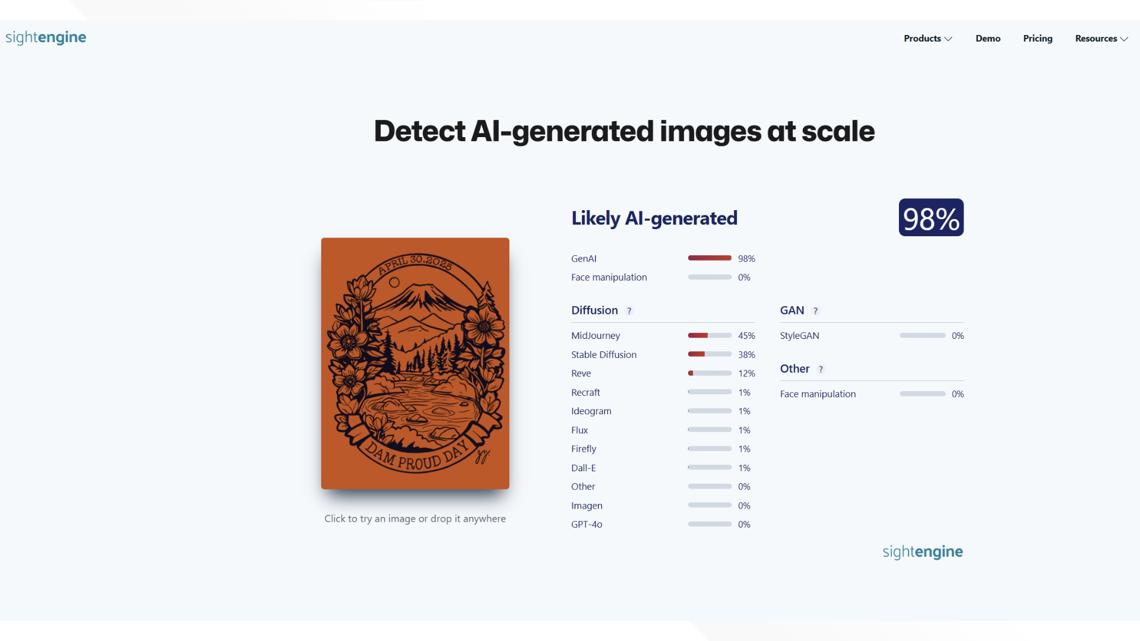
Did an AI-generated design win an Oregon State University T-shirt contest?
作者:Author: Evan Watson
A simple competition for a "Dam Proud Day" T-shirt design sparked a conversation about art and artificial intelligence among OSU students and alumni.
CORVALLIS, Ore. — A T-shirt design competition at Oregon State University is sparking questions about the intersection of art and artificial intelligence.
The contest's controversial winner received $1,000 and will have their "Dam Proud Day" design printed on thousands of shirts for an upcoming day of giving, but was the design AI-generated?
Madeline Langford, an OSU freshman and aspiring digital artist, submitted a design in the competition, pitched by the OSU Foundation as a contest for students to "get involved with the mission of Oregon State and influence the greater Beaver community."
Langford's design didn't win the contest, which she said she understood. However, when she saw the finalists, something felt off to her.
She put the winning design through an AI detector, and it gave her a result that said the design was 99% likely to be AI-generated.
"A little upsetting that they would choose an AI design over a student's true, genuine artwork," Langford said.
Her gut feeling about AI-involvement in the design contest would start a campus-wide conversation about art and AI, the crossover between creativity and computers, and the contrast between the efficiencies of technology and the fostering of young artists.
"I really don't care whether I made it or not, it just felt like a slap in the face to say, 'Yeah, your design didn't make it, but this AI one did,'" Langford told KGW. "Not only for me, but for every other artist that worked hard on that competition."


Langford emailed the OSU Foundation, letting them know that the multiple design finalists appeared to her to have been AI-generated.
An official responded, saying the university values student creativity and the human skill it takes to make a great design, but the OSU Foundation doesn't "have a definitive way to verify whether a design was AI-generated."
Langford replied with some ideas, including asking the artists to share proof of their design layers — common elements for digital art — or running the submission through multiple AI detectors. She said she didn't get another response.
The OSU Foundation later shared that the alleged AI-generated design was the winner. It will be printed on 2,000 shirts for Dam Proud Day on April 30. A foundation spokesperson said the design was selected through an open vote by students and the OSU community.
Langford posted her emails and a photo of the winning design on social media sites, asking other Beavers what they thought about her takeaways. Most Reddit commenters shared her frustration.
"I was waiting for the picture slide to be maybe even a little contentious," one user said. "No ... blatant as day."
Others commented on the primary mountain not resembling a mountain in Oregon, looking more like Mount Fuji or perhaps Mount St. Helens.
"This is so frustrating OSU, do better," said another commenter.
Artists pointed out inconsistencies with trees in the design, doubling and converging lines, and other elements that appeared to show trademarks of AI-generated artwork.
The OSU Foundation hid and disabled comments on its Instagram post announcing the winner. In its contest rules, the foundation said "AI use is discouraged," but not outright disqualifying. The contest finalists' names were not shared publicly.
Molly Brown, associate vice president of marketing and communication for the OSU Foundation, told KGW in a statement that those regulations played a key role.
"Our contest guidelines recommended against the use of AI, but did not explicitly prohibit it," Brown said. "As a result, we did not ask the contestants if they used AI, nor did we disqualify entries based on suspected or alleged AI use."
KGW asked if the OSU Foundation will either allow or prohibit AI use in any similar design contests in the future. Brown did not answer that question.
AI, art, and the ethics conversation
Can you know, with certainty, that artwork is AI-generated? Isabel Bo-Linn, a professor at Portland State University who teaches a course on AI and design, says it's difficult to tell.
"I have more of an eye as a professional designer," Bo-Linn said. "Now, I cannot explicitly look at something and tell you whether or not you used artificial intelligence."
KGW tested the contest-winning artwork through multiple online AI detectors, which flagged the design as 98% likely to be AI-generated. However, AI detectors aren't foolproof, and designs can be a mix of AI and human creativity.


"Even those detector systems we can't really elicit full trust from because we aren't entirely clear on how they function," Bo-Linn said. "Plus, did the artist use AI for the entire design? For ideation? What percentage of the design was AI versus the artist's? It gets very convoluted."
KGW also tried to generate its own AI design, entering the contest rules into AI image generators. With some stylistic differences, the results largely echoed the winning design, featuring a centered mountain, a river flowing forward toward the viewers, and trees on either side with text up top and at the bottom.
Bo-Linn said design competitions should be more explicit in their rules about the use of artificial intelligence, especially when there's a cash prize involved.
"Other design competitions I've seen have gone so far as to have separate categories where you have a category that is strictly not AI-generated art, and one that is," she said.
At an industry crossroads, Bo-Linn said the arts community and broader public have an opportunity to set a precedent for how artists navigate an AI-driven world and how culture values art, while recognizing ethical concerns with AI art generation.
"These AI models have sort of scraped the internet and scraped the works of artists to train a model, primarily without the informed consent of these artists," Bo-Linn said.
Langford echoed artists' complaints with AI overreach.
"Most of the time it's without (artists') permission and compensation," she said, referencing AI model training.
Still, Bo-Linn said she is optimistic and believes artists should frame the future by using AI to their advantage.
"It's threatening as long as we allow it to be threatening," Bo-Linn said.
Jobs and contests may change, but artists and consumers can invest in what technology just can’t match, she said.
"Emphasizing the aspects of the creative process that are still intrinsically human, and lot of that is tied to storytelling and strategy and empathy and human stories and inspiration," Bo-Linn said.
For Langford — currently a freshman in college who's now in competition with, seemingly, the entire internet — the conversation can feel daunting.
"It's kind of furthering that idea that it's a little scary to see what will happen in the future. Like, is anyone's art safe?" she said. "Will there become a point where we ever truly know if it's AI or a human design?"